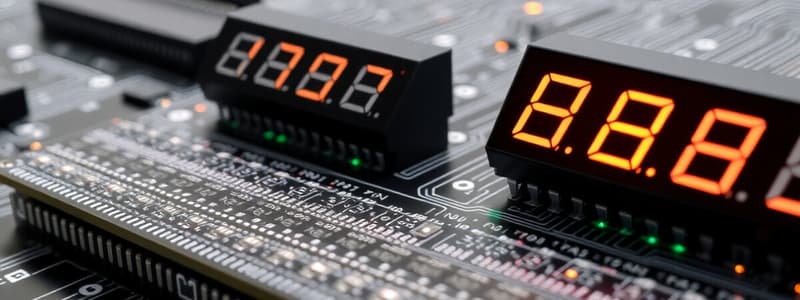Podcast
Questions and Answers
A 1-bit register changes its output only when the load is high.
A 1-bit register changes its output only when the load is high.
True (A)
The output of a flip-flop takes the value of the load signal on a falling edge of load ∧ CLK.
The output of a flip-flop takes the value of the load signal on a falling edge of load ∧ CLK.
False (B)
If the load is low, the value of the output in a 1-bit register changes to the input value regardless of the clock signal.
If the load is low, the value of the output in a 1-bit register changes to the input value regardless of the clock signal.
False (B)
When load oscillates while CLK is high, the output becomes stable.
When load oscillates while CLK is high, the output becomes stable.
The design of a simple 1-bit register is the same as that of a D flip-flop.
The design of a simple 1-bit register is the same as that of a D flip-flop.
In building a 1-bit register, it is acceptable to manipulate the clock signal freely.
In building a 1-bit register, it is acceptable to manipulate the clock signal freely.
An edge-triggered circuit is represented by a triangle symbol.
An edge-triggered circuit is represented by a triangle symbol.
In the truth table for a 1-bit register, when in is X and load is 0, outnew is always 0.
In the truth table for a 1-bit register, when in is X and load is 0, outnew is always 0.
The primary purpose of a clock signal in digital circuits is to keep the circuits synchronized.
The primary purpose of a clock signal in digital circuits is to keep the circuits synchronized.
A K-map can be used to expand a truth table for a 1-bit register.
A K-map can be used to expand a truth table for a 1-bit register.
A D flip-flop can function without a clock signal.
A D flip-flop can function without a clock signal.
The Hack CPU uses 8-bit registers to store binary values.
The Hack CPU uses 8-bit registers to store binary values.
If a D flip-flop's load signal is high, its output remains unchanged.
If a D flip-flop's load signal is high, its output remains unchanged.
The clock signal in digital circuits is sometimes omitted from circuit diagrams to save space.
The clock signal in digital circuits is sometimes omitted from circuit diagrams to save space.
A bus in digital logic is represented by a single wire carrying multiple bits of information.
A bus in digital logic is represented by a single wire carrying multiple bits of information.
Each of the 16-bit registers in the Hack CPU is treated as holding multiple distinct binary values.
Each of the 16-bit registers in the Hack CPU is treated as holding multiple distinct binary values.
Flashcards are hidden until you start studying
Study Notes
Clocked Circuits
- Clocked circuits are driven by a single clock signal (CLK)
- Edge-triggered circuits are denoted by a triangle.
- The clock signal is often not explicitly drawn, as all circuits use the same clock.
1-Bit Registers
- A 1-bit register is a simple modification of a D flip-flop.
- It has three inputs: "in", "load", and the clock signal (CLK).
- It has one output "out".
- When the clock signal rises, the register updates its output:
- If "load" is high, "out" takes on the value of "in".
- If "load" is low, "out" remains unchanged.
- A common design error is to directly connect "load" to the clock input of the D flip-flop.
- This can lead to unstable output if "load" oscillates while the clock is high.
- Instead, the correct approach is to use combinatorial logic to determine the register's input based on its previous output and the external signals.
1-Bit Register Design
- The correct register design considers the following input combinations:
- in, load, outold, outnew
- X = don't care
- 0 0 0 0
- X 0 1 1
- 0 1 X 0
- 1 1 X 1
- This logic can be implemented using a multiplexer.
Multi-Bit Registers
- Multi-bit registers store multiple bits (e.g., 16-bit registers in the Hack CPU).
- They have the same structure as 1-bit registers, but operate on a bus (a single wire representing a binary value).
- The bus simplifies representation, as it doesn't require drawing individual wires for each bit.
Studying That Suits You
Use AI to generate personalized quizzes and flashcards to suit your learning preferences.



